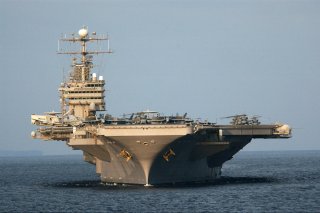Abraham Lincoln: The U.S. Navy Aircraft Carrier Every Nation Fears
Over the past 30 years, the carrier has carried out multiple humanitarian missions in the Persian Gulf and Pacific regions, as well as combat operations.
Warships often receive colorful nicknames, and it isn't entirely clear why the fifth Nimitz-class aircraft carrier to enter service in the United States Navy was dubbed "Black Pearl," but given the ship's record there clearly was no curse tied to the USS Abraham Lincoln (CVN-72).
The second Navy ship to be named after the former president, she has served as the flagship for Carrier Strike Group 12 (CSG-12) since April 2019.
An Incredible History
Over the past 30 years, the carrier has carried out multiple humanitarian missions in the Persian Gulf and Pacific regions, as well as combat operations.
Launched in 1988, USS Abraham Lincoln was delivered to the U.S. Navy in 1989. She is similar in design to the other Nimitz-class carriers – and is 1,092 feet in length, has a beam of 252 feet and a draught of 41feet.
The warship displaces 97,000 tons while her flight deck, which is approximately 4.5 acres, is serviced by four hanger elevators. The carrier is also equipped with four steam catapults and can carry up to ninety fixed-wing and rotary aircraft. As a floating airport, the carrier is home to 5,680 sailors and Marines, including a crew of 3,200 as well as 2,480 serving in the airwing.
USS Abraham Lincoln was ordered on her first Western Pacific deployment in response to Operation Desert Shield/Desert Storm in 1991. However, while en route to the Indian Ocean, the warship was diverted to support evacuation operations following the eruption of Mt. Pinatubo on Luzon Island, Republic of the Philippines, and led the efforts of Operation Fiery Vigil, the largest peacetime evacuation of active-duty military personnel and family members in history. The carrier led a twenty-three-ship armada that successfully sea lifted 20,000 evacuees.
CVN-72 took part in Operations Southern Watch and Vigilant Sentinel in the late 1990s and was ordered to the Persian Gulf to take part in Operational Iraqi Freedom. Beginning in 2013, the warship underwent her mid-life refueling and complex overhaul, during which more than 2.5 million man-hours of work were conducted on the ship. She rejoined the fleet in May 2017.
With the completion of its forty-nine-and-a-half-month overhaul, Abraham Lincoln also became the first carrier in the U.S. Navy's fleet that will be able to operate Lockheed Martin F-35C Joint Strike Fighters from its decks.
A Record Breaker
In January 2020, the carrier arrived at her new homeport in San Diego, completing a record-breaking 295 days at sea, the longest post-Cold War era deployment for any U.S. aircraft carrier.
The Black Pearl also has had some notable firsts during her service.
She also became the first Pacific Fleet carrier to integrate female aviators into the crew after the Combat Exclusion Laws were lifted in April 1993. USS Abraham Lincoln also became the first carrier to have a female commander, after the Navy announced in December 2020 that Capt. Amy Bauernschmidt would assume command. She was previously the first woman to serve as an executive officer (XO) onboard a carrier – a position she also held on the Abraham Lincoln from September 2016 to January 2019. The native of Milwaukee, Wisconsin graduated from the United States Naval Academy in May 1994, the first graduating class in which women were allowed to serve aboard combatant ships and aircraft.
Peter Suciu is a Michigan-based writer who has contributed to more than four dozen magazines, newspapers and websites. He regularly writes about military small arms, and is the author of several books on military headgear including A Gallery of Military Headdress, which is available on Amazon.com.

